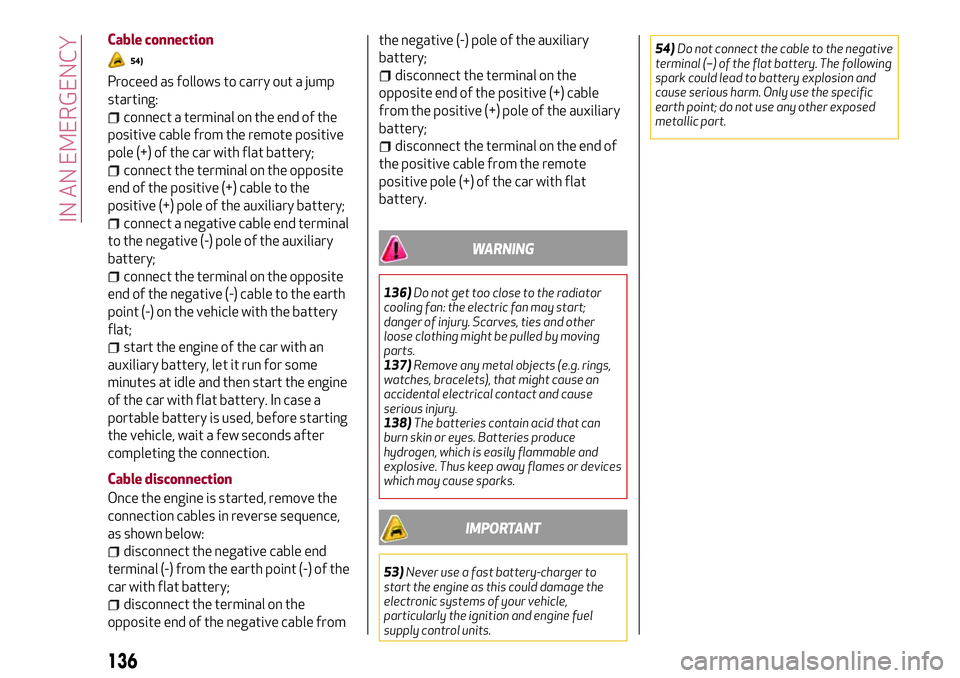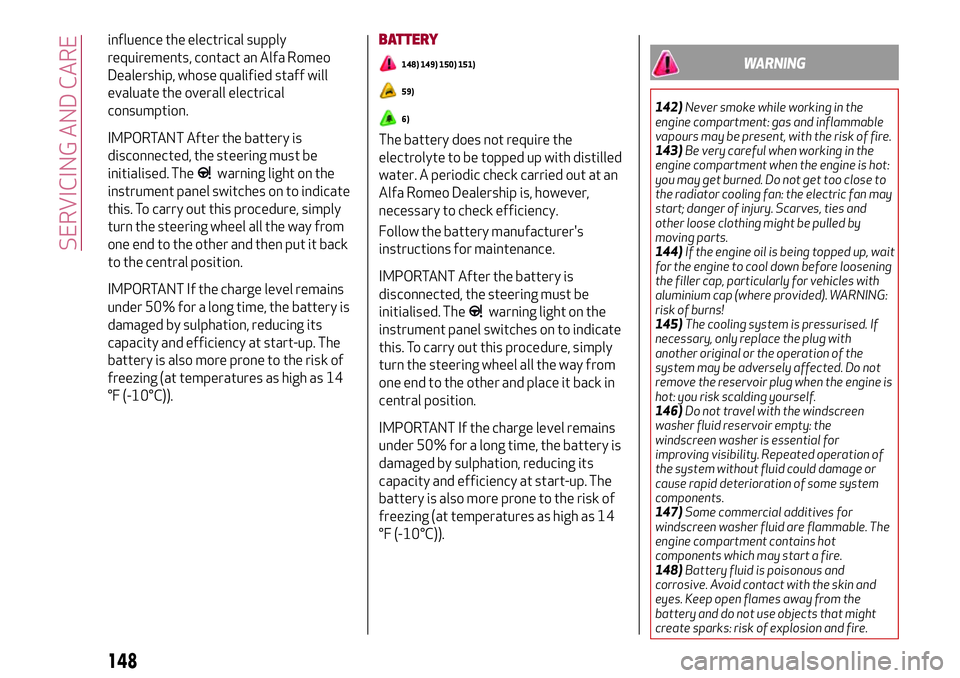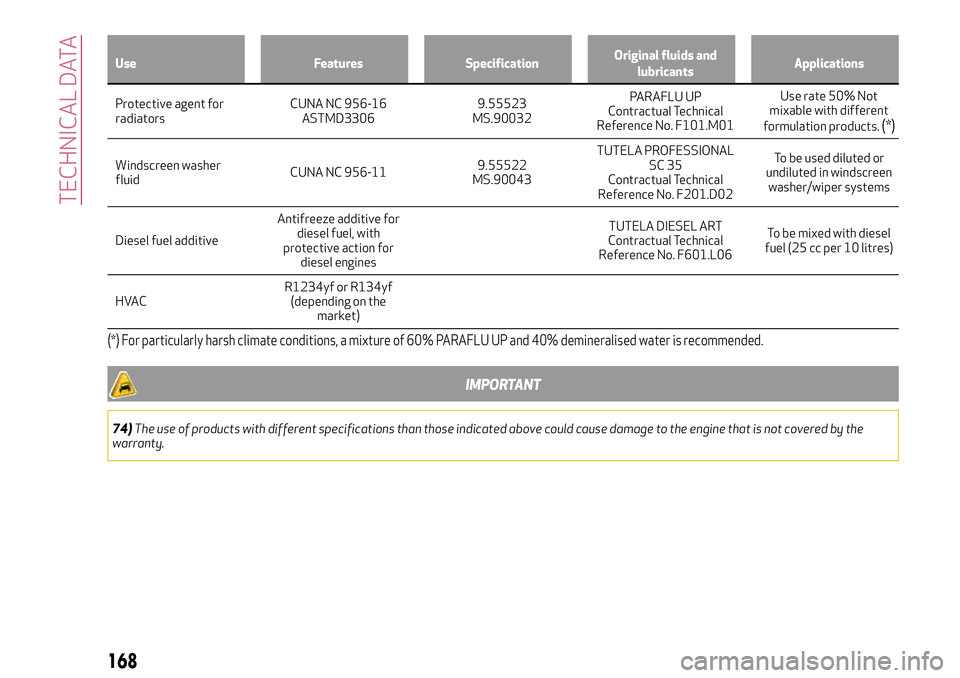radiator Alfa Romeo Giulia 2016 Owner's Manual
[x] Cancel search | Manufacturer: ALFA ROMEO, Model Year: 2016, Model line: Giulia, Model: Alfa Romeo Giulia 2016Pages: 204, PDF Size: 4.95 MB
Page 138 of 204

Cable connection
54)
Proceed as follows to carry out a jump
starting:
connect a terminal on the end of the
positive cable from the remote positive
pole (+) of the car with flat battery;
connect the terminal on the opposite
end of the positive (+) cable to the
positive (+) pole of the auxiliary battery;
connect a negative cable end terminal
to the negative (-) pole of the auxiliary
battery;
connect the terminal on the opposite
end of the negative (-) cable to the earth
point (-) on the vehicle with the battery
flat;
start the engine of the car with an
auxiliary battery, let it run for some
minutes at idle and then start the engine
of the car with flat battery. In case a
portable battery is used, before starting
the vehicle, wait a few seconds after
completing the connection.
Cable disconnection
Once the engine is started, remove the
connection cables in reverse sequence,
as shown below:
disconnect the negative cable end
terminal (-) from the earth point (-) of the
car with flat battery;
disconnect the terminal on the
opposite end of the negative cable fromthe negative (-) pole of the auxiliary
battery;
disconnect the terminal on the
opposite end of the positive (+) cable
from the positive (+) pole of the auxiliary
battery;
disconnect the terminal on the end of
the positive cable from the remote
positive pole (+) of the car with flat
battery.
WARNING
136)Do not get too close to the radiator
cooling fan: the electric fan may start;
danger of injury. Scarves, ties and other
loose clothing might be pulled by moving
parts.
137)Remove any metal objects (e.g. rings,
watches, bracelets), that might cause an
accidental electrical contact and cause
serious injury.
138)The batteries contain acid that can
burn skin or eyes. Batteries produce
hydrogen, which is easily flammable and
explosive. Thus keep away flames or devices
which may cause sparks.
IMPORTANT
53)Never use a fast battery-charger to
start the engine as this could damage the
electronic systems of your vehicle,
particularly the ignition and engine fuel
supply control units.54)Do not connect the cable to the negative
terminal (–) of the flat battery. The following
spark could lead to battery explosion and
cause serious harm. Only use the specific
earth point; do not use any other exposed
metallic part.
136
IN AN EMERGENCY
Page 150 of 204

influence the electrical supply
requirements, contact an Alfa Romeo
Dealership, whose qualified staff will
evaluate the overall electrical
consumption.
IMPORTANT After the battery is
disconnected, the steering must be
initialised. The
warning light on the
instrument panel switches on to indicate
this. To carry out this procedure, simply
turn the steering wheel all the way from
one end to the other and then put it back
to the central position.
IMPORTANT If the charge level remains
under 50% for a long time, the battery is
damaged by sulphation, reducing its
capacity and efficiency at start-up. The
battery is also more prone to the risk of
freezing (at temperatures as high as 14
°F (-10°C)).BATTERY
148) 149) 150) 151)
59)
6)
The battery does not require the
electrolyte to be topped up with distilled
water. A periodic check carried out at an
Alfa Romeo Dealership is, however,
necessary to check efficiency.
Follow the battery manufacturer's
instructions for maintenance.
IMPORTANT After the battery is
disconnected, the steering must be
initialised. The
warning light on the
instrument panel switches on to indicate
this. To carry out this procedure, simply
turn the steering wheel all the way from
one end to the other and place it back in
central position.
IMPORTANT If the charge level remains
under 50% for a long time, the battery is
damaged by sulphation, reducing its
capacity and efficiency at start-up. The
battery is also more prone to the risk of
freezing (at temperatures as high as 14
°F (-10°C)).
WARNING
142)Never smoke while working in the
engine compartment: gas and inflammable
vapours may be present, with the risk of fire.
143)Be very careful when working in the
engine compartment when the engine is hot:
you may get burned. Do not get too close to
the radiator cooling fan: the electric fan may
start; danger of injury. Scarves, ties and
other loose clothing might be pulled by
moving parts.
144)If the engine oil is being topped up, wait
for the engine to cool down before loosening
the filler cap, particularly for vehicles with
aluminium cap (where provided). WARNING:
risk of burns!
145)The cooling system is pressurised. If
necessary, only replace the plug with
another original or the operation of the
system may be adversely affected. Do not
remove the reservoir plug when the engine is
hot: you risk scalding yourself.
146)Do not travel with the windscreen
washer fluid reservoir empty: the
windscreen washer is essential for
improving visibility. Repeated operation of
the system without fluid could damage or
cause rapid deterioration of some system
components.
147)Some commercial additives for
windscreen washer fluid are flammable. The
engine compartment contains hot
components which may start a fire.
148)Battery fluid is poisonous and
corrosive. Avoid contact with the skin and
eyes. Keep open flames away from the
battery and do not use objects that might
create sparks: risk of explosion and fire.
148
SERVICING AND CARE
Page 170 of 204

Use Features SpecificationOriginal fluids and
lubricantsApplications
Protective agent for
radiatorsCUNA NC 956-16
ASTMD33069.55523
MS.90032PARAFLU UP
Contractual Technical
Reference No. F101.M01Use rate 50% Not
mixable with different
formulation products.
(*)
Windscreen washer
fluidCUNA NC 956-119.55522
MS.90043TUTELA PROFESSIONAL
SC 35
Contractual Technical
Reference No. F201.D02To be used diluted or
undiluted in windscreen
washer/wiper systems
Diesel fuel additiveAntifreeze additive for
diesel fuel, with
protective action for
diesel enginesTUTELA DIESEL ART
Contractual Technical
Reference No. F601.L06To be mixed with diesel
fuel (25 cc per 10 litres)
HVACR1234yf or R134yf
(depending on the
market)
(*) For particularly harsh climate conditions, a mixture of 60% PARAFLU UP and 40% demineralised water is recommended.
IMPORTANT
74)The use of products with different specifications than those indicated above could cause damage to the engine that is not covered by the
warranty.
168
TECHNICAL DATA